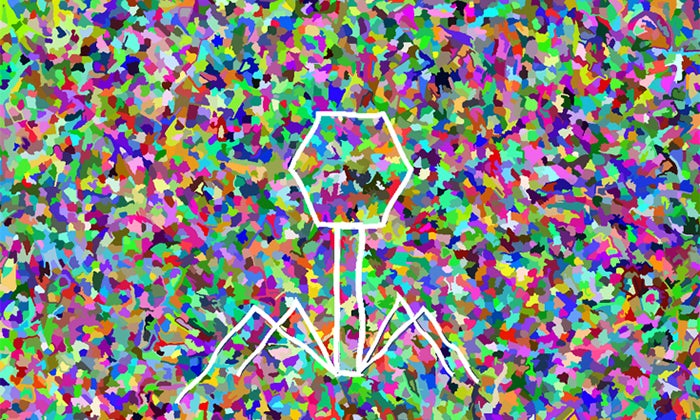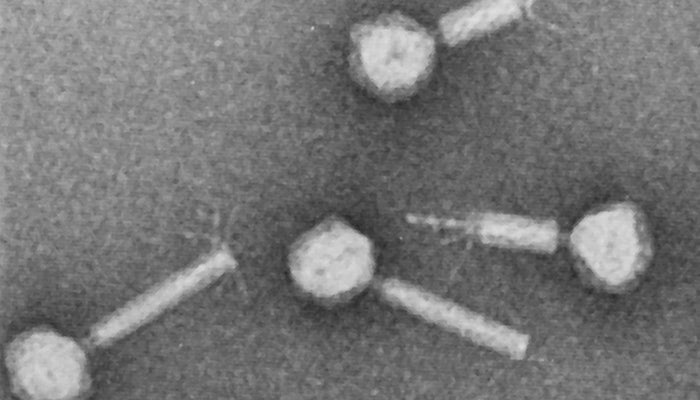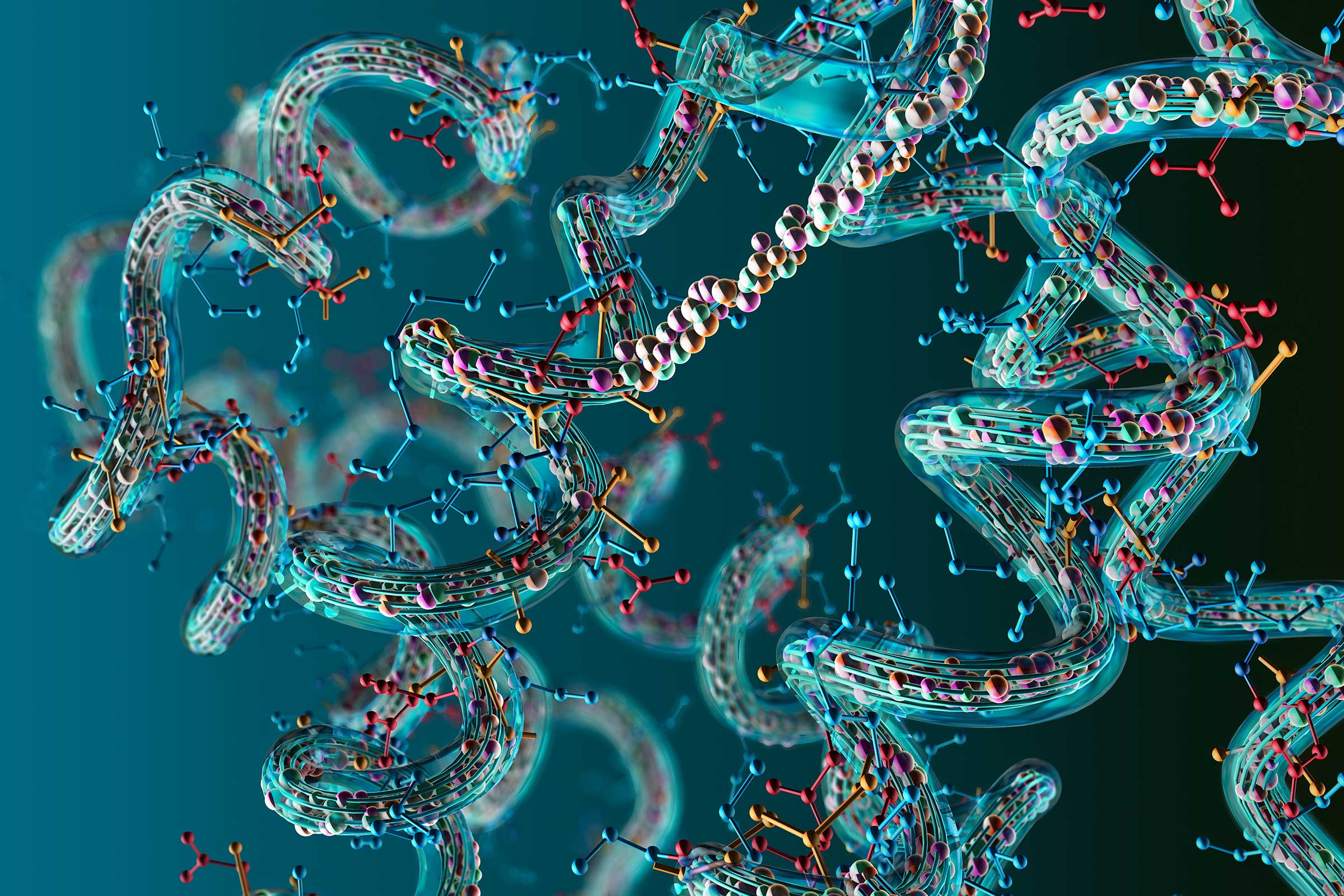How Chromosomes Organize and Genes Interact Needs Rethinking, Study Finds
Bacterial DNA much more twisted than originally thought.

Akin to the well-mixed colors in Jackson Pollock’s ‘Convergence’, the findings reported by transposable phage Mu highlight that all loci in the E. coli genome intermix spatially to promote widespread contacts, independent of linear distance. Here Pollock’s famous painting was passed through a watershed segmentation filter with colors chosen randomly to provide the same sense of a well-mixed image or chromosome. The part inside of the stylized Mu remains unperturbed by the filter to convey that Mu allows us to see how things really are. Concept credit: Rasika Harshey and David Walker. Image credit: David Walker.
The organization of genetic information in most bacteria – long thought to occur in a single ordered, segmented ring – turns out to more closely mimic a spaghetti noodle: shifting, balling up and twisting in ways scientists previously had not grasped. The finding by researchers at The University of Texas at Austin, appears today in Cell, with implications for cancer and bacterial infectious disease research, as well as our most basic understanding about the structure of all living cells.
It all began about five years ago, when Rasika Harshey was sitting in a meeting of other molecular biologists as a speaker discussed E. coli, a common bacterium found in our gut.
She listened as the speaker discussed how E. coli's single chromosome was organized, presenting evidence that there were hard boundaries between the different regions of the chromosome and that the different genes didn't interact across those regions. For the past 40 years, Harshey, a professor of molecular biosciences at the University of Texas at Austin, has studied a bacteriophage, a virus called Mu that preys on bacteria like E. coli.
"What I was hearing didn't jive with what I knew about Mu," Harshey said. "I just wanted to do one test."

Electron microscope images of the Mu bacteriophage. Courtesy of Rasika Harshey.
Five years later, that test has evolved into a series of experiments that, in essence, shake biologists' understanding of how chromosomes are organized and how genes interact. Harshey's findings challenge previous notions about a tendency for genetic information to compartmentalize.
The discovery, made in bacteria, almost certainly carries over to all living things. At its heart, it suggests scientists previously subscribed to an illusion that life's information is rigidly organized within chromosomes, as opposed to having the flexibility and fluidity that Harshey's team has revealed.
Her work with Mu was key. A stealthy virus that inserts its genetic code into the E. coli genome, Mu 'jumps' to other sections of the chromosome, where it peels off a copy of itself without popping out of its original location. If the E. coli chromosome was so compartmentalized, as biologists believed, Harshey wondered, how was Mu able to make those jumps?
"I grew up with detective novels, and I love a good mystery," Harshey said. "That's what keeps me going, the mysteries."
She devised an experiment where Mu was initially located at a specific position in the E. coli chromosome. To cause Mu to jump, the scientists subjected a batch of a billion E. coli cells, all with Mu in the same location, to a change in temperature. David Walker, a postdoctoral researcher working in Harshey's lab, conducted the experiment and analyzed the DNA sequence of all the cells. Mu had inserted itself in a random place in each cell in the population, with roughly equal frequency throughout the genome. Extending the experiment, Walker and Harshey were able to observe that the genome was well-mixed, with some sections in close physical proximity to each other that were nowhere near each other in the genetic sequence.
What this told the team was that there were no hard barriers between different regions of the chromosome. Rather than looking like a segmented ring, the way scientists had been thinking, E. coli's chromosome probably looks more like a spaghetti noodle, in which any given position is roughly equally likely to be in contact with any other position.
The team also noticed that while the E. coli chromosome was well-mixed, several genes with similar functions 'cluster' in 3D space. While exploring the basis of this phenomenon, they discovered that condensin, a protein responsible for compacting the genome, also contributed to the well-mixed chromosome. When the team removed a section of the chromosome that coded for condensin, the pattern of Mu movement around the chromosome changed. It actually made the chromosome look segmented, the way scientists had believed it was.
Because condensin is found in the cells of everything from bacteria to humans, the findings could have potential bearing on the whole tree of life. Scientists believe that human chromosomes are at least somewhat compartmentalized, too, but the new findings suggest that there must be widespread contact between DNA segments within each chromosome and likely between chromosomes as well. This would explain 'illegitimate' recombination events that lead to chromosomal rearrangements with deleterious effects, including cancer. Recombination events are also an evolutionary driver and these findings may offer new insight into that process.
"The work took nearly five years, but it takes a long time if you're going to shake the foundations," Harshey said.
Peter Freddolino of the University of Michigan also contributed to the research. The research was funded by the National Institutes of Health and the Robert Welch Foundation. Computing resources were provided via the Texas Advanced Computing Center (TACC), the University of
Michigan's Great Lakes Cluster and the Extreme Science and Engineering Discovery Environment, which is supported by the National Science Foundation.



